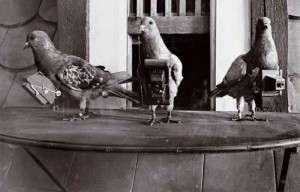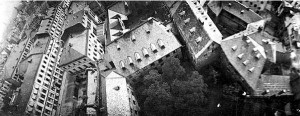By Juliet Wagner (Regular Contributor)
 Between 1903 and 1906, Julius Neubronner, a pharmacist in a small town near Frankfurt, would regularly receive prescriptions and deliver small quantities of medication to a nearby sanatorium by carrier pigeon. After a particular pigeon that had been missing for a few weeks returned to him in good health, Neubronner wondered where the truant pigeon had been, and his curiosity inspired him to design a special automatic camera-suit for his birds that took photographs beneath them as they flew.
Between 1903 and 1906, Julius Neubronner, a pharmacist in a small town near Frankfurt, would regularly receive prescriptions and deliver small quantities of medication to a nearby sanatorium by carrier pigeon. After a particular pigeon that had been missing for a few weeks returned to him in good health, Neubronner wondered where the truant pigeon had been, and his curiosity inspired him to design a special automatic camera-suit for his birds that took photographs beneath them as they flew.
A New Flock of Spies?
Although Neubronner’s original motivation was to spy on his pigeons, it soon became clear to him that the pigeons themselves could be employed as airborne spies, and he was quick to tout the potential military applications of pigeon photography after he patented his device in 1908. His design took advantage of the fairly consistent altitude of pigeon flight to calculate focal length, and different versions of the suit had different camera features. Neubronner also developed a mobile dovecote with an enlarged landing entrance to accommodate the extra bulk of his flying photographers’ gear.
The poor birds modeling the suits on these photographs were probably stuffed, but Neubronner did successfully demonstrate the camera-suit on live pigeons. He used beautiful images of the German landscape –askance and framed by the tips of the photographer’s wings—to prove it.
Drone Prototypes
The Prussian military was negotiating with Neubronner to purchase his camera-suit technology and team of pigeons when the First World War broke out in August 1914. Bowing to national emergency, Neubronner’s pigeons were drafted and reportedly tested with some success by the Prussian army, but were never used widely. The promise of small, reliable, unobtrusive airborne spies was not truly fulfilled until the widespread use of drones by the US military almost a century later.
No longer an exclusively military technology, drones are becoming common in much less ominous settings. Drone photography is now used for class photo group shots, for example, replacing the old-school photographer on her precarious stepladder, and is also applied to analyze football plays, supervise farmland and to entertain crowds at public events. In a reversal of Neubronner’s innovation, amazon.com has recently proposed using drones to deliver packages.
Like the humble pigeon, however, 21st century drones are not without predators. The latest online drone-video craze features impressive drone-eye-view hawk attacks.
For more on Julius Neubronner:
Franziska Brons, “Bilder im Fluge: Julius Neubronners Brieftaubenfotografie” Fotogeschichte: Beiträge zur Geshichte un Äesthetik der Fotografie, Jahrgang 26, Heft 100 (2006), pp. 17-36.
As well as a pharmacist and inventor, Neubronner was an amateur film enthusiast. A short film he made performing magic tricks in 1904 is viewable here (his pigeons feature!).
Additional images of Neubronner’s pigeons and the views they captured are available here.
Juliet Wagner is a Research Assistant Professor of History at Vanderbilt University, where she is also an active participant in colloquia in ‘Medicine, Health and Society’ and at the Penn Warren Humanities Center. She is currently completing the final touches on her first book, on film and shell shock during the First World War, which argues that the notion of “suggestion” was central to both trauma and cinema in the early twentieth century.

